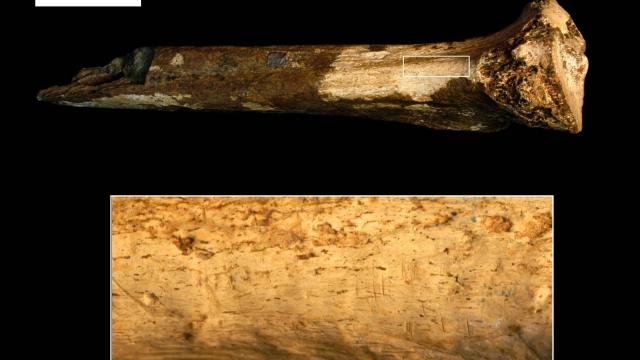In 1970, the renowned paleoanthropologist Mary Leakey found an ancient, nondescript leg bone sitting on the ground in Ileret, Kenya. Now, 53 years on, a research team has found marks on the bone they believe could be evidence of “systematic cannibalism” in the hominin fossil record.
The tibia, dated to around 1.45 million years old, has a series of small cut marks perpendicular to the bone. It’s not certain which species the tibia belonged to, but it certainly wasn’t ours, as Homo sapiens wouldn’t appear for several hundred thousand more years.
The new research paper describes several cut marks along the bone consistent with someone related to us slicing meat off something else related to us. The research was published today in Scientific Reports.
“[We] don’t know who was eaten, not sure who did the eating,” said Briana Pobiner, a paleoanthropologist at the Smithsonian Institution’s National Museum of Natural History and the study’s lead author, in a phone call with Gizmodo.
“The thing that makes it complicated is that in this area of northern Kenya, there are three different species that we have fossil evidence for,” she added. “We have Paranthropus boisei, we have Homo erectus and we have Homo habilis. So really any of them could have been the stone tool wielders who made these butchering marks.”
Other evidence of hominins butchering hominins exists. Neanderthals did it, as did Homo sapiens, based on evidence from Africa and Europe. But the previous oldest evidence for cut marks on a hominin fossil (which dates to between 2.6 million and 1.5 million years old) has recently been questioned; the marks, one team argued, were from natural processes, not hominin tool use.
Pobiner recently studied 199 postcranial (i.e. everything below the skull) hominin fossils at the National Museums of Kenya Nairobi Museum. Many of the fossils were found by excavations decades ago, including those conducted by Mary Leakey and her husband Louis. Of the near-200 bones Pobiner investigated, only one — the 28th she studied — had evident cut marks.
“I saw this really beautifully preserved patch of bone,” Pobiner said. “When I looked closer, I saw these marks and I thought, ‘I know exactly what these are.’ I’ve seen hundreds of animal fossils with these marks on them, but never a hominin fossil.”
Pobiner made molds of the cut marks and sent them to her eventual co-author, Michael Pante, a paleoanthropologist at Colorado State University. Pobiner gave no information about the marks and asked Pante to make his own conclusion about their maker. Pante scanned the molds and compared them against a database of nearly 900 similar marks.
Ancient cut marks were made with stone tools, a technology which ancient hominins honed over millions of years. The oldest known tools are just over three million years old, and earlier this year cut animal bones — found alongside the largest hominin tooth yet known — broadened the geographic distribution and age of the Oldowan toolkit, a linchpin of hominin technology.
Hominins used stone tools to make three kinds of butchery marks, each of which indicate the type of cutting the individual was trying to do. Skinning marks occur on ankle bones and other areas from which skin can be peeled. Disarticulation marks are less precise, and indicate that the carcass in question was just being cut up, perhaps for transport. But the marks Pobiner spotted were defleshing marks, made across the bone to — you guessed it — remove flesh and other edible bits.
Because it was not possible to describe the species on either side of this grisly Pleistocene encounter, the researchers stopped short of describing it as cannibalism, in which an individual of a certain species eats another member of the same species.
“This study is exemplary and shows that new behavioural information can be obtained with modern observations and the application of novel technologies from old museum collections,” said Michael Petraglia, the director of the Australian Research Centre for Human Evolution at Griffith University, who was unaffiliated with the recent paper, in an email to Gizmodo.
“It is entirely possible that this is a case of cannibalism at 1.45 million years ago,” Petraglia added. “However, we should be cautious as this is an isolated fossil and we can not be certain what hominin species processed the lower leg of the individual.”
Besides that, he added, the cut marks don’t indicate whether the bone was cut up for nutritional reasons (that is, eating) or for ritual purposes.
The tibia also had tooth marks which the research team compared with the marks made by carnivores in the area. The most similar marks to those on the bones were the bite marks of big cats — perhaps saber-toothed cats, which roamed the area at the time. At some point, a prehistoric felid bit down on the unfortunate hominin.
Whether the big cats or another hominin got to the evidently eaten individual first is impossible to say. The big cats may have made a kill and a hominin with a stone tool made a chance find, or vice versa. Pobiner said that there aren’t any technologies that could further clarify the sequence of events.
“Except for a time machine,” she added. “Can I write that into my next grant proposal?”
